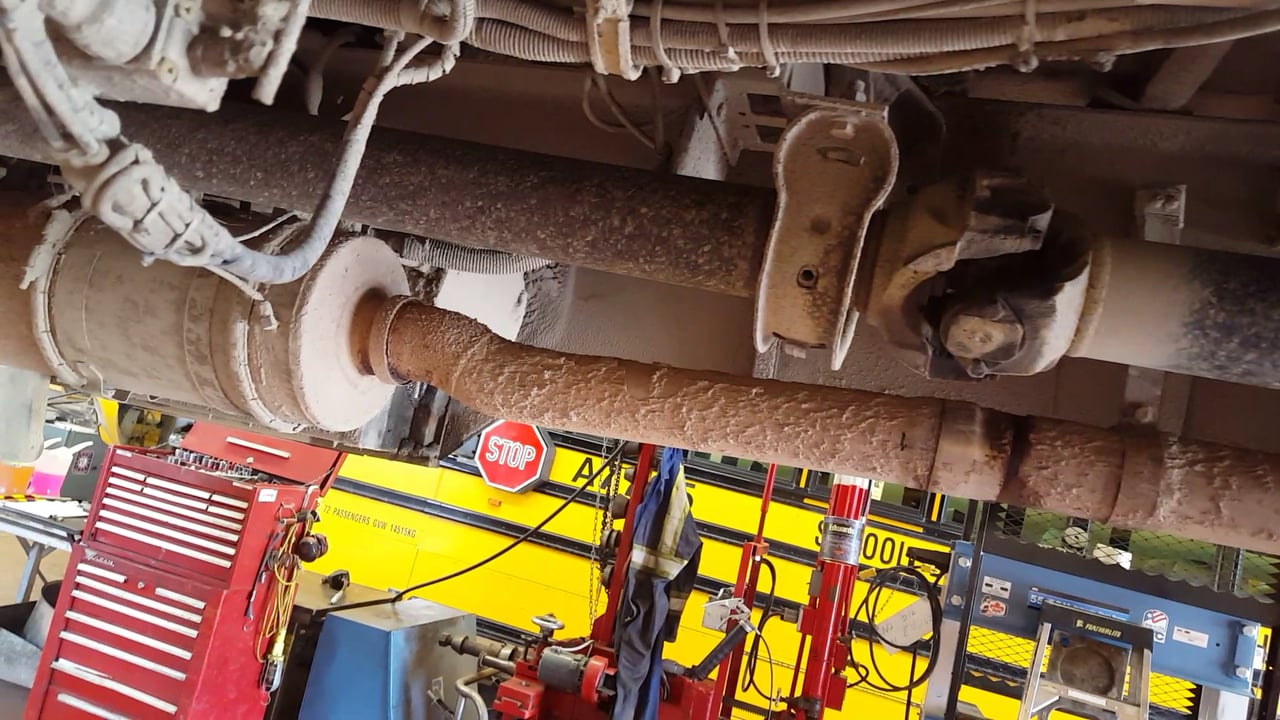Before starting with the school district 20 years ago all of the servicing I performed was on a floor creeper. Lying on my back sliding over a 35 foot span of a vehicle to do a visual and carry out maintenance and repairs was tedious at times. Having a vehicle hoist to work on a commercial vehicle is a tremendous advantage to do visual checks, adjustments and repairs.
Our fleet of 77 buses are inspected every 5,000 kilometers so it’s a daily routine to have one or two units to go over. The bus is brought in and the first step is checking lights. Headlights, clearance lts, signals, brake lts, reverse and loading lights. the stop arms and crossgate arms are checked out at the same time. The school bus has a master switch on the dash that is left on during a run. When the driver pulls up to a stop he hits another switch called a amber warning switch.
The 4 amber LEDs come on to alert traffic that the bus is coming to a stop. When the bus stops at it’s destination all the driver has to do is open the entrance door which triggers the 4 red warning lights one on each corner. At the same time the stop sign with LED lights flips out towards oncoming traffic along with the crossgate on the bumper. The crossgate keeps the students well in front of the driver so he can see what’s going on.
LED lights are very economical in the long run because they last for years and since they have such a high illumination the government inspection allows 30% burnout on them. We’ve had LEDs last up to 7 years. It’s no wonder they come with a 5 year warranty. One LED loading light at present costs around $180.00 but the longevity and time saved not maintaining lights pays off.
Servicing also involves inspecting and checking air brake stroke. The maximum allowable push rod stroke is 2.5 inches on a long stroke brake pot. We started specifying nothing but long stroke brakes years ago. They are designed to give an extra 1/2 inch stroke to add to the safety and reliability of the brake system. Air leaks and foundation brake condition is also important. Any cracks or deterioration on the linings or air leaks during a brake application means the bus is down until the fault is repaired.
U-joints are inspected and greased and steady bearings that support the drive shaft are checked for deterioration. the wiring harnesses along the frame are abundant and need to be secure. There’s a lot going on when the bus is in transit with bumps and vibrations that can lead to wiring insulation break down or shorts and open circuits due to all of the agitation a bus goes through on a run. The plastic loom that all vehicles come with is the main culprit with wear on the wiring insulation from years of rubbing and vibration from a harness that might be strung too tight.
The galvanized exhaust parts that come out of the manufacturer’s factories are not wear proof simply because metal that heats up and cools down and is subjected to moisture inside the piping does not last. Rust is evident soon after a bus goes into service and usually in a year some exhaust parts have to be replaced. There is no better way to inspect and repair exhaust systems than the shop hoist.
A bus on the hoist allows us to check wheel bearings, spin the tires around to check for defects and maintain correct tire pressures. Oil leaks can be tracked down easily when the technician can look up and see where the source of the leak is. Sometimes we simply add an engine oil dye that shows up bright fluorescent when using a black light directed at the area of the leak. Oil levels and top end checks on the engine are done with the bus down on the floor along with a steering wheel wiggle to inspect the steering linkage.
The interior of the bus is just as important with emergency windows and roof hatches that are alarmed. These systems must work along with easy opening action on all doors and windows and everything inside the bus must be secured. The seats have hold downs that must be latched as well. Walking down the aisle we grab each seat bottom and tug on it to make sure it’s solid on the frame.
There are no seat belts in our buses because of the legislation that says it’s alright to have kids riding in a school bus due to the design of the seat backs that cushion the blow in case of an accident. This is called compartmentalization which absorbs the impact as long as the students are sitting properly. Standees will definitely get injured. These checks are part of the everyday routine in a school bus garage.







